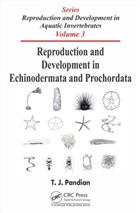Reproduction and Development in Echinodermata and Prochordata
- Series : Reproduction and Development in Aquatic Invertebrates
Volume: 3 - Publisher : CRC Press
- Illustrations : 59 b/w illus, 75 b/w tables
Our customers have not yet submitted a review for this title - click here to be the first to write a review
Description:
Echinoderms and prochordates occupy a key position in vertebrate evolution. The genomes of sea urchin share 70% homology with humans. Researches on cell cycle in sea urchin and phagocytosis in asteroids have fetched Nobel Prizes. In this context, this book assumes immense importance. Echinoderms are unique, as their symmetry is bilateral in larvae but pentamerous radial in adults. The latter has eliminated the development of an anterior head and bilateral appendages. Further, the obligate need to face the substratum for locomotion and acquisition of food has eliminated their planktonic and nektonic existence. Egg size, a decisive factor in recruitment, increases with decreasing depths up to 2,000-5,000 m in lecithotrophic asteroids and ophiuroids but remains constant in their planktotrophics. Smaller (< 18 mm) ophiuroids do not produce a lecithotrophic eggs but larger (> 110 mm) asteroids generate planktotrophic eggs only. Publications on sex ratio of echinoderms indicate the genetic determination of sex at fertilization but those on hybridization, karyotype and ploidy induction do not provide evidence for heterogametism. But the herbivorous echinoids and larvacea with their gonads harboring both germ cells and Nutritive Phagocytes (NPs) have economized the transportation and hormonal costs on gonadal function. Despite the amazing potential just 2 and 3% of echinoderms undergo clonal reproduction and regeneration, respectively. Fission is triggered, when adequate reserve nutrients are accumulated. It is the most prevalent mode of clonal reproduction in holothuroids, asteroids and ophiuroids. However, budding is a more prevalent mode of clonal reproduction in colonial hemichordates and urochordates. In echinoderms, fission and budding eliminate each other. Similarly, autoregulation of early development eliminates clonal reproduction in echinoids and solitary urochordates. In pterobranchs, thaliaceans and ascidians, the repeated and rapid budding leads to colonial formation. Coloniality imposes reductions in species number and body size, generation time and life span, gonad number and fecundity as well as switching from gonochorism to simultaneous hermaphorditism and oviparity to ovoviviparity/viviparity.
Other titles from the series : Reproduction and Development in Aquatic Invertebrates
Click to view all titles in this series...
You may also like...
Catalog of Recent Ophiuroid Type Specimens in Major Collections in the United
Downey, M.E.
Price £15.00
Catalogue of the British Echinoderms in the British Museum (Natural History):
Bell, F.J.
Price £25.00
A Contribution to the Study of Ophiurans of the United States National Museum
Koehler, R.
Price £15.00
Asteroidea of the North Pacific and Adjacent Waters. Part 1. Phanerozonia and
Fisher, W.K.
Price £30.00


















